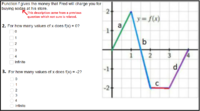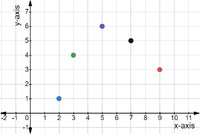The graph structure came from a previous question so I added the detail about it being about sodas. How ever we don't really know if the story carries over from the previous question.. the previous was just asking if it was increasing, decreasing or constant for each segment. The value go negative which means giving money?? So that being said...

For the first question, our thinking is that the graph crosses x axis 3 times.. so we think 3 would be the right answer. However if you have to only select integers, then it would be 2. What is also confusing is that you can select multiple answers which I think there would only be one.
For the second question.. it is more confusing to us. I say the value is 2, but my son thinks 3.
Thank you for your time and insight on this problem!

For the first question, our thinking is that the graph crosses x axis 3 times.. so we think 3 would be the right answer. However if you have to only select integers, then it would be 2. What is also confusing is that you can select multiple answers which I think there would only be one.
For the second question.. it is more confusing to us. I say the value is 2, but my son thinks 3.
Thank you for your time and insight on this problem!

